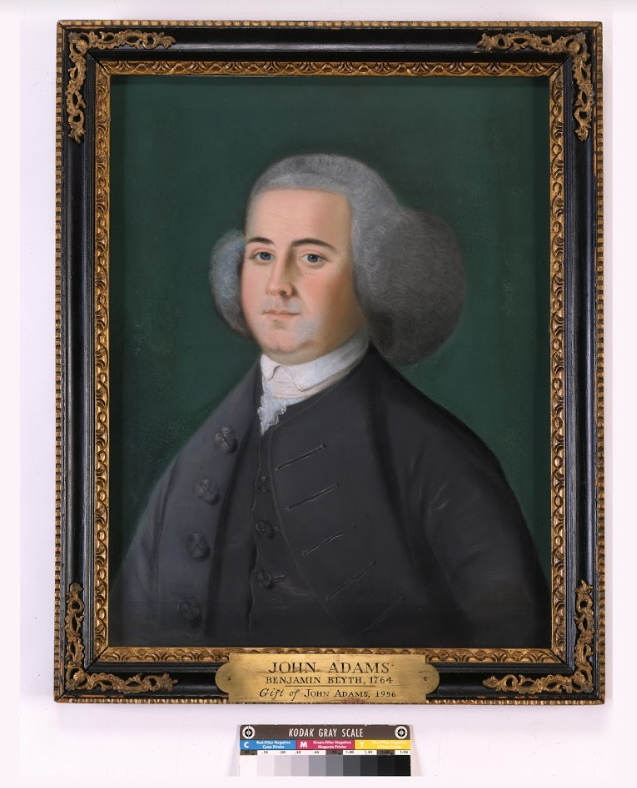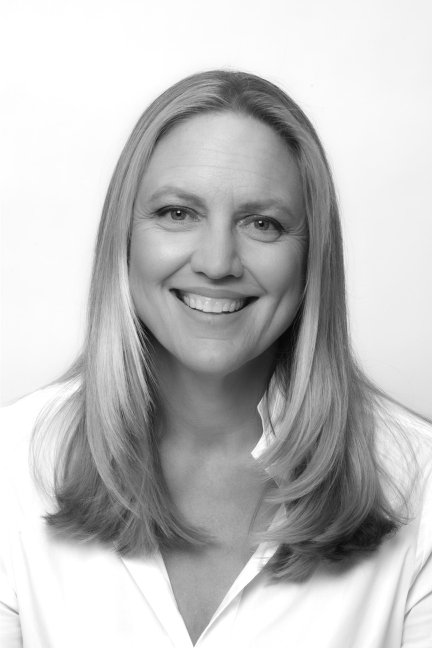by Nina Sankovitch
In the following excerpt from American Rebels, Nina Sankovitch discusses the education of John Hancock and John Adams from childhood schoolhouses and tutors to Harvard.

This image is in the public domain via Wikicommons. [PD-US Expired]
In July 1744, Thomas Hancock, younger brother to the recently deceased Reverend John Hancock, traveled from Boston to Lexington. Accompanied by his wife, Lydia, he traveled in a sturdy black coach edged in gilt and upholstered in thick maroon velvet. It was a fine coach but nothing like the one Thomas had ordered from England, due to arrive any month now. The new coach would be ivory-colored, with silver trim; the coat of arms that Thomas had fashioned himself—an emblem with three cocks, a dragon’s tail, and a raised fist—would be painted in red and gold over its doors. Underneath the coat of arms, in gold script, the coachmaker had been ordered to carefully paint the family motto that Thomas had invented: Nul Plaisir Sans Peine. No pleasure without pain.
Thomas and Lydia now traveled to Lexington to save their fatherless nephew John from a life of pain and bring him into a life of pleasure, in the form of wealth, education, and privileges that he had never imagined.
As happy as Lydia and Thomas were together, and as wealthy as they were, they were unable to fulfill one of their most ardent wishes: to have a child. After Thomas’ brother John died, it seemed the natural course of things to take on his oldest son as their protégé and adopted son. They would bring John Hancock to Boston to be educated, loved, and launched into the world as a representative of the House of Hancock.
It would not have taken long for young John to pack up his belongings in Lexington; little that he had there, where he lived off the frugal generosity of his grandfather, would be needed in Boston. For John’s mother, Mary, the decision to let her son go to Boston was an easy one. Her own prospects were dim, living as she did with her father-in-law; she knew that if her son John got on well under the tutelage of Uncle Thomas, he would help out his two siblings in a way that the old bishop could not. She bid her son to do his best and write often, and promised there would be visits between the families. Thomas promised the same, and John took his leave of Lexington.
* * * * *

News of young Hancock’s move to Boston quickly traveled to the village of Braintree. Already aware of the division separating him from the Quincy boys, John Adams, son of Deacon Adams, now had to accept that his childhood companion John Hancock was vaulting up into a higher social register—but through no action of his own. What was the use of hard work if a mere schoolboy could be lifted to wealth in one morning, while John Adams had only the prospect of farming and local government—the summit of his father’s achievements—to look forward to?
Envy would plague John Adams throughout his life, both driving him forward and driving him mad: “The Scituation that I am in, and the Advantages that I enjoy, are thought to be the best for me by him who alone is a competent Judge of Fitness and Propriety. Shall I then complain? Oh Madness, Pride, Impiety.”
John had many happy childhood memories, spent “in making and sailing boats and Ships upon the Ponds and Brooks, in making and flying Kites, in driving hoops, playing marbles, playing Quoits, Wrestling, Swimming, Skaiting and above all in shooting.” When he was still just a boy of eight or nine, his schoolteacher, Joseph Cleverly, forbade John from bringing his gun with him to school. John left the firearm hidden away close by the school and picked it up after class, proceeding to shoot at crows and squirrels all the way home.
John later credited both his parents with teaching him important lessons for life, but he especially idolized his father: “In wisdom, piety, benevolence and charity . . . I have never known his superior.” When at age ten John professed his desire to leave school and become a farmer, his father, who harbored high hopes for his firstborn, said nothing to discourage his young son. Instead, he sent John to spend a day in muddy fields, where he was tasked with cutting thatch, a laborious and painful undertaking.
When his father asked him if he was now ready to pursue his studies, John answered that as raw as his fingers were, and as sore his back, school was simply a terrible chore for him. His father shook his head and sent John back to school the next day; John went but “was not so happy as among the Creek Thatch.”
According to John, the fault lay in his teacher: “Mr. Cleverly was through his whole Life the most indolent Man I ever knew. His inattention to his Schollars was such as gave me a disgust to Schools, to books and to study.” When John at age fourteen again asked his father for permission to leave school and become a farmer, his father replied, “I have set my heart upon your Education.” He asked John why he would not study harder and go to college. John answered simply: “Sir I don’t like my Schoolmaster. He is so negligent and so cross that I never can learn anything under him.”
Father and son soon reached an agreement: if Adams could find a new school for John, the boy promised to “apply myself to my Studies as closely as my nature will admit, and go to Colledge.” And so, at age fourteen, John was sent as a day student to a local school for boarders run by Joseph Marsh.
The kindly and intelligent Marsh was finally able to inspire John Adams in his studies; his father “soon observed the relaxation of my Zeal” for guns, and “my daily increasing Attention to my books.” As a reward for his hard work, Marsh gave John a small book containing Cicero’s orations. On the flyleaf, John wrote his name six times, as if to make sure of his possession of the treasured tome; he would keep it his whole life.
Later, he wrote to a friend that there was nothing like reciting Cicero to make one feel better: “It exercises my Lungs, raises my Spirits, opens my Pores, quickens the Circulations, and so contributes much to Health.”
* * * * *
John Hancock’s education since being taken under the wing of Thomas and Lydia had been one of both privilege and expectations. The best of all was given to him—the finest clothes, a carriage for his own use, a magnificent bedroom, the huge manicured yard, and indeed the entire Boston Common at his door to play in. A private tutor was brought in to teach John, as his health was delicate (and would be all his life), and then at the age of eleven, he was enrolled in the Boston Latin School, run by the demanding taskmaster John Lovell. There he learned Latin, Greek, a bit of history and arithmetic, and the most important skill of all, handwriting. The last hour of every school day, a day which began at 7:00 a.m. and ended at 5:00 p.m., was spent in perfecting penmanship. This was his favorite hour at school; time spent at arithmetic came in a close second.
John used his great skill at writing to pen letters to his mother in Lexington, and to his sister and grandmother. When his grandmother fell ill, John offered to send a gift of “two oranges and six lemons.” Citrus was a treasure beyond measure in those days, and his offer underlined both his generosity (thanks to his uncle) and his kindness (which he would demonstrate all his life).
Thomas Hancock was well pleased with his nephew’s growing talents. Good handwriting and agility at sums were both important to the career Thomas had in mind for John. More skills would be learned at Harvard, which John began to attend in the fall of 1750, and Thomas also began to bring his nephew with him to the offices of the House of Hancock and down to Clark’s Wharf. (Early in the 1750s, Thomas renamed the wharf after himself, and it would from then on be known as Hancock’s Wharf.) It was on the docks of Boston that John became enthralled with the work of his uncle, all the ships coming and going, with their wares from all over the world.
* * * * *
Under the tutelage of Joseph Marsh, it took John Adams less than a year to be fully prepared to sit for Harvard’s entrance exams. In June 1751 notice of the exams was published in the local papers: they would be held in early July. John was all set to go when at the last minute, Marsh told John he couldn’t accompany his student to Cambridge—John would have to face the examiners on his own. John was terrified; he set out on “a very melancholy journey” and, despite all his preparations, arrived in Cambridge certain that he would fail in the exams.
Presenting himself at Harvard Hall, he was brought into the examination room. He seated himself in a chair facing Edward Holyoke, president of Harvard, along with four other men, all tutors of the college. Henry Flynt, cousin to the Quincys, was one of the tutors. John took a deep breath and began the examination, first taking on a Latin translation (fortunately, he was allowed the use of a dictionary as an aid to his memory) and continuing from there. In the end, he acquitted himself well, “was declared admitted,” and given a “Theme . . . to write on in the Vacation.”
Deacon Adams, overjoyed, happily sold off ten acres of his farm to pay the college tuition, and John began his classes in the fall of 1751. He was fifteen, the oldest freshman in his class. Both the Quincy boys and John Hancock were already at Harvard, after being prepared at the elite Boston Latin School. Edmund Quincy was a senior, and Samuel Quincy and John Hancock were sophomores.
It was a time of reunion for the boys from Braintree. Samuel and Edmund Quincy, John Hancock, and John Adams renewed their childhood friendships. They socialized together, talking politics—Ned, as Edmund Quincy was called, was already a fiery proponent of the rights of colonists—and playing cards. But a sense of social distinctions lingered—or at least so John Adams imagined. Class rankings at Harvard at the time were based on social standing, and despite the boost Adams received for having the Boylston name on his mother’s side, all the Quincy boys and John Hancock would consistently be ranked above him—and the fact of it, inked on paper for the world to see, rankled.
John Adams had worked hard for his place, but the economic fortunes of others seemed to count for more than his own meritorious efforts. He would just have to work harder, he decided. He knew those boys weren’t better than him, and he would show the world it was so.

Nina Sankovitch is the author of several nonfiction books, including American Rebels and The Lowells of Massachusetts. She has written for the New York Times, the Huffington Post as a contributing blogger, and was formerly a judge for The Book of the Month Club. A graduate of Tufts University and Harvard Law School, Sankovitch grew up in Evanston, Illinois, and currently lives in Connecticut with her family.
